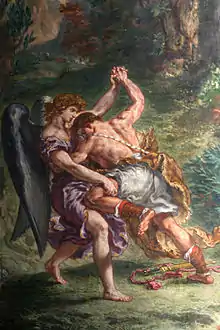Penuel
In the Hebrew Bible, Penuel (or Pniel, Pnuel; Hebrew: פְּנוּאֵל) is described as a place not far from Succoth, on the east of the Jordan River and south of the river Jabbok. It is also called Peniel "Face of God" by Jacob:
It is because I saw God face to face, and yet my life was spared.
— Gen. 32:30 NIV

Here Jacob wrestled (Gen. 32:24–32) "with a man" ("the angel", Hos. 12:4) "till the break of day." This episode resulted in God (or the angel) changing Jacob's name to "Israel" (Gen. 32:28) which literally means, "he who strives with God" or "God strives".[1]
According to 1 Kings (Judges 8:8; 1 Kings 12:25, Jeroboam built Penuel when the tribes separated from Judah. In the scriptures it is identified as both an el-site and a Jahwist site.[2] The men of this place refused to give bread to Gideon and his three hundred men when they were in pursuit of the Midianites (Judges 8:1–21). On his return, Gideon tore down the tower there and killed all the men of the city.
When the Northern Kingdom of Israel broke away from the United Monarchy c. 930 BCE, Jeroboam, its first king, established his capital in Shechem. A short time later, he left Shechem and fortified Penuel, declaring it as his new capital (I Kings 12:25). He and his son, Nadab, ruled there, until Baasha seized the throne in 909 BCE and moved the capital to Tirzah (I Kings 15:25–34).
‘Pnuel’ is also a common name given to males in Assyrian culture.
Some scholars consider that the material of Genesis 32-35, including the account of Jacob being renamed Israel at Penuel, may be a later addition that introduces a new power structure centered around the establishment of sacral places in the North (Penuel, Shechem and Bethel).[3]
See also
Vayishlach, the Torah reading describing the events at Penuel.
References
- Kierkegaard, Søren. Fear and Trembling. p. 13.
- Nohrnberg, James. Like Unto Moses: The Constituting of an Interruption. p. 295.
- Carr, David M. Reading the Fractures of Genesis: Historical and Literary Approaches. p. 298.
![]() This article incorporates text from a publication now in the public domain: Easton, Matthew George (1897). Easton's Bible Dictionary (New and revised ed.). T. Nelson and Sons. Missing or empty
This article incorporates text from a publication now in the public domain: Easton, Matthew George (1897). Easton's Bible Dictionary (New and revised ed.). T. Nelson and Sons. Missing or empty |title= (help)